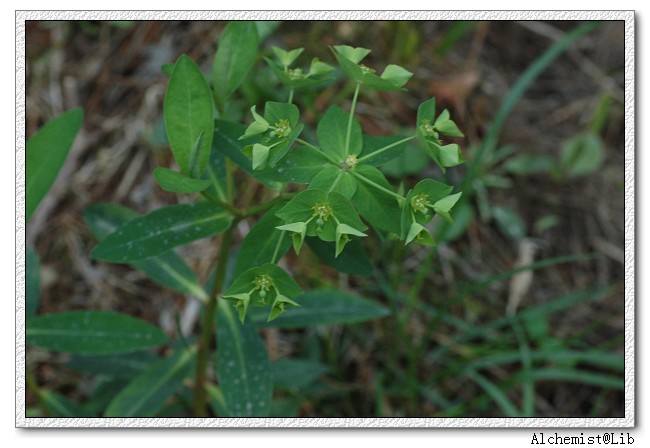- Scientific Name: Euphorbia sieboldiana C.Morren & Decne.
- Ref: Bull. Acad. Roy. Sci. Bruxelles 3:174. 1836
- Synonyms:
- Euphorbia bodinieri H.Lév. & Vaniot
- E. erythraea Hemsl.
- E. esquirolii H.Lév. & Vaniot
- E. glaucopoda Diels
- E. guilielmii A.Gray
- E. henryi Hemsl.
- E. hippocrepica Hemsl.
- E. idzuensis Nakai ex Hurus.
- E. kangdingensis W.T.Wang
- E. kangdingensis var. puberula W.T.Wang
- E. luticola Hand.-Mazz.
- E. savaryi Kiss
- E. sieboldiana var. grandifolia (Franch. & Sav. ex Hurus.) Oudejans
- E. sieboldiana var. idzuensis (Hurus.) Oudejans
- E. sieboldiana var. ohsumiensis (Hurus.) Hatus.
- E. sieboldiana var. peninsularis (Hurus.) Kitag.
- E. sieboldiana var. sylvatica (Hurus.) Oudejans
- E. szechuanica Pax & K.Hoffm.
- E. taquetii H.Lév. & Vaniot
- E. tsukamotoi Honda
- Galarhoeus hippocrepicus (Hemsl.) Hurus.
- G. luticola (Hand.-Mazz.) Hurus.
- G. sieboldianus (C.Morren & Decne.) H.Hara
- Tithymalus erythraeus (Hemsl.) Soják
- T. henryi (Hemsl.) Soják
- T. hippocrepicus (Hemsl.) Soják
- T. sieboldianus (C.Morren & Decne.) H.Hara
- T. szechuanicus (Pax & K.Hoffm.) Soják
- English Common Name: Siebold’s spurge
- Chinese Common Name: 钩腺大戟 gōuxiàn dàjǐ, 马蹄大戟 mǎtí dàjǐ, 长角大戟 chángjiǎo dàjǐ, 黄土大戟 huángtǔ dàjǐ, 长圆叶大戟 chángyuán∙yè dàjǐ, 康定大戟 Kāngdìng dàjǐ
- Japanese Common Name: ナツトウダイ [夏燈台] natsutōdai
- Family: Euphorbiaceae
- Genus: Euphorbia
- Distribution: Fields, scrub, forest margins, sparse forests, grasslands. Throughout China except Fujian, Hainan, Nei Mongol, Qinghai, Taiwan, Xinjiang, Xizang [Japan, Korea, Russia (Far East)].
- Photo: 04/07/2007, Qingliang Peak, Zhejiang
Herbs, (22-)40-70 cm tall. Rootstock extensively rhizomatous, 10-20 cm, rhizomes 4-15 mm thick, segmented/moniliform. Stems single or clustered, (2-)4-7 mm thick, often with branchlets from upper nodes, smooth and glabrous. Leaves alternate, progressively larger toward apex; stipules absent; basal scale-leaves soon lost; petiole absent or nearly so; leaf blade elliptic, obovate-lanceolate, or oblong-elliptic, very variable, 2-5(-10) × 0.5-1.5(-3) cm, glabrous, base attenuate or cuneate, (crenulate or) entire, apex obtuse, acute, or acuminate; lateral veins pinnate. Inflorescence a terminal pseudumbel; primary involucral leaves 3-5(or 6), elliptic or ovate-elliptic, 1.5-2.5(-4.2) cm × 0.4-0.8(-2.8) mm, base subtruncate, apex obtuse, primary rays 3-5(or 6), 2-4(-7) cm; cymes mostly dichasial, sometimes becoming monochasial; cyathophylls 2, very variable, reniform-rounded, ovate-triangular, or rounded, 0.8-1.4(-1.8) × 0.8-1.6(-3.2) cm, base very broadly cuneate, shallowly cordate, or subrounded, apex rounded. Cyathium shortly stalked; involucre cuplike, 3-4 × 3-5 mm, lobes triangular or ovate-triangular, shortly pilose inside; glands 4, mainly yellow-brown, sometimes pale yellow or yellow-green, crescent-shaped, tips extended into 2 slender horns, horns obtuse to needlelike, very variable. Male flowers many, exserted from involucre. Female flower: ovary exserted from cup, smooth, glabrous; styles connate for less than 1/4 length, persistent but easily lost; style arms 2-lobed. Capsule 3-lobed, (3-)3.5-4 × 4-5 mm, smooth, glabrous. Seeds subterete-globose, ca. 2.5 × 1.5 mm, gray-brown, smooth; caruncle present, small, sessile. Fl. and fr. Apr-Sep. (Flora of China)
